Automotive supplier Denso has released a retrofittable driver status monitor in Japan that detects distractions and drowsiness to reduce accidents involving commercial vehicles. The platform carries out checks based on a driver’s facial image, which is captured through a camera installed in the cabin.
Denso’s monitor voices an alert if the driver is not paying attention or is seated inappropriately.
The driver’s condition is recorded on a secure digital (SD) card. An operation manager can view the nu
May 17, 2018
Read time: 2 mins
Automotive supplier Denso has released a retrofittable driver status monitor in Japan that detects distractions and drowsiness to reduce accidents involving commercial vehicles. The platform carries out checks based on a driver’s facial image, which is captured through a camera installed in the cabin.
Denso’s monitor voices an alert if the driver is not paying attention or is seated inappropriately.
The driver’s condition is recorded on a secure digital (SD) card. An operation manager can view the number of voiced alerts as well as an image of the driver at the time the alert was triggered. In addition, real-time notifications of the driver’s state allow the manager to make suggestions for action in emergency situations.
The monitor can be linked to Denso’s new telematics device for commercial vehicles - available this summer - and a cloud-based digital tachograph manufactured by Fujistu.
Denso will release the monitor outside Japan later this year.










